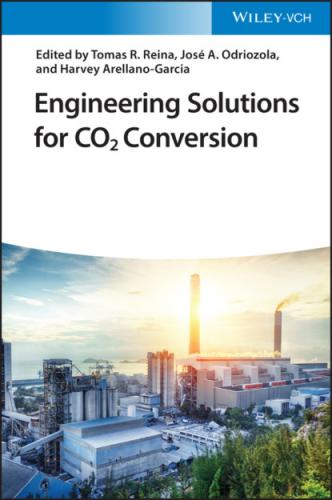Engineering Solutions for CO2 Conversion
Edited by
Tomas R. Reina José A. Odriozola Harvey Arellano‐Garcia
Editors
Dr. Tomas R. Reina
University of Surrey
Department of Chemical & Process Engineering
388 Stag Hill
GU2 7XH Guildford, Surrey
United Kingdom
Prof. José A. Odriozola
Universidad of Sevilla
Inorganic Chemistry Department
4 San Fernando Street
41004 Sevilla
Spain
Prof. Harvey Arellano‐Garcia
University of Surrey
Department of Chemical & Process Engineering
388 Stag Hill
GU2 7XH Guildford, Surrey
United Kingdom
Cover Image: © cozyta/Getty Images
All books published by Wiley‐VCH are carefully produced. Nevertheless, authors, editors, and publisher do not warrant the information contained in these books, including this book, to be free of errors. Readers are advised to keep in mind that statements, data, illustrations, procedural details or other items may inadvertently be inaccurate.
Library of Congress Card No.:
applied for
British Library Cataloguing‐in‐Publication Data
A catalogue record for this book is available from the British Library.
Bibliographic information published by
the Deutsche Nationalbibliothek
The Deutsche Nationalbibliothek lists this publication in the Deutsche Nationalbibliografie; detailed bibliographic data are available on the Internet at <http://dnb.d-nb.de>.
© 2021 WILEY‐VCH GmbH, Boschstr. 12, 69469 Weinheim, Germany
All rights reserved (including those of translation into other languages). No part of this book may be reproduced in any form – by photoprinting, microfilm, or any other means – nor transmitted or translated into a machine language without written permission from the publishers. Registered names, trademarks, etc. used in this book, even when not specifically marked as such, are not to be considered unprotected by law.
Print ISBN: 978‐3‐527‐34639‐4
ePDF ISBN: 978‐3‐527‐34650‐9
ePub ISBN: 978‐3‐527‐34651‐6
oBook ISBN: 978‐3‐527‐34652‐3
1 CO2 Capture – A Brief Review of Technologies and Its Integration
Mónica García1, Theo Chronopoulos2, and Rubén M. Montañés3
1International Energy Agency‐ Greenhouse Gas R&D Programme (IEAGHG), Pure Offices, Hatherley Lane, Cheltenham, GL51 6SH, United Kingdom
2128/15 Hoxton Street, N1 6SH, London, United Kingdom
3Energy Technology, Chalmers University of Technology, Department of Space, Earth and Environment, Hörsalsvägen 7B, SE‐412 96, Gothenburg, Sweden
1.1 Introduction: The Role of Carbon Capture
The Intergovernmental Panel for Climate Change (IPCC) recently released the special report on 1.5C [1] and pointed out the need to implement all available tools to cut down CO2 emissions. Energy efficiency, fuel switching, renewables, and carbon capture represent the largest impact on CO2 emission reduction in power and industrial sectors. Carbon capture represents a contribution of 23% in the “Beyond 2 degrees scenario” (B2DS) modeled by the International Energy Agency (IEA)1 and has other interesting characteristics that increase its value beyond its cost: (i) easiness to retrofit current power plants or industrial facilities,2 (ii) simplicity to integrate that in the electricity grid and offer an interesting tool to cover the intermittency of renewables, (iii) ideal to cut down industrial process emissions that otherwise cannot suffer deep reductions, and (iv) current carbon budgets rely on negative emissions to compensate the use of fossil fuels [1]. Carbon capture combined with bioenergy (BECCS) can provide negative emissions at large scale in an immediate future.
CO2 capture (also called CO2 sequestration or carbon capture) involves a group of technologies aiming to separate CO2 from other compounds released during the production of energy or industrial products, obtaining a CO2‐rich gas that can be stored or used for the obtention of valuable products. The main classification of CO2 capture technologies relies on where in the process the CO2 separation occurs. For the power sector, it can be divided into pre‐, oxy‐, and post‐combustion. For the industrial sector, the classification is similar, although their integration would be different. In addition, other new arrangements are emerging.
1.2 CO2 Capture Technologies
1.2.1 Status of CO2 Capture Deployment
GCCSI reported in 2018 23 large‐scale CCS facilities in operation or under construction globally, summing up 37 MtCO2 per year. This wide range of facilities shows the versatility of CO2 capture processes.3
In the power sector, the United States is leading the implementation deployment, although Europe has the highest CO2 capture capacity. The Boundary Dam project (Canada) and Petra Nova (USA) are pioneers in reaching commercial scale. Moreover, based on the successful results of the Boundary Dam project, a CO2 capture facility has been planned for the Shand power facility (Canada), incorporating not only learnings from the Boundary Dam but also enhanced thermal integration and tailored design. The results show a significant cost reduction [2]. Also in Canada, the Quest project completes the list of Canadian CCS projects in operation [3] and The National Energy Laboratory (NET) power project recently appeared in the United States as a potential significant reduction on CO2 capture costs [4].
In the industrial sector, cement, steel, refining, chemicals, heavy oil, hydrogen, waste‐to‐energy, fertilizers, and natural gas have been identified by the Carbon Sequestration Leadership Forum (CSLF; https://www.cslforum.org) as the main intensive emitter industries. As it is highlighted, the Norcem Brevik plant
